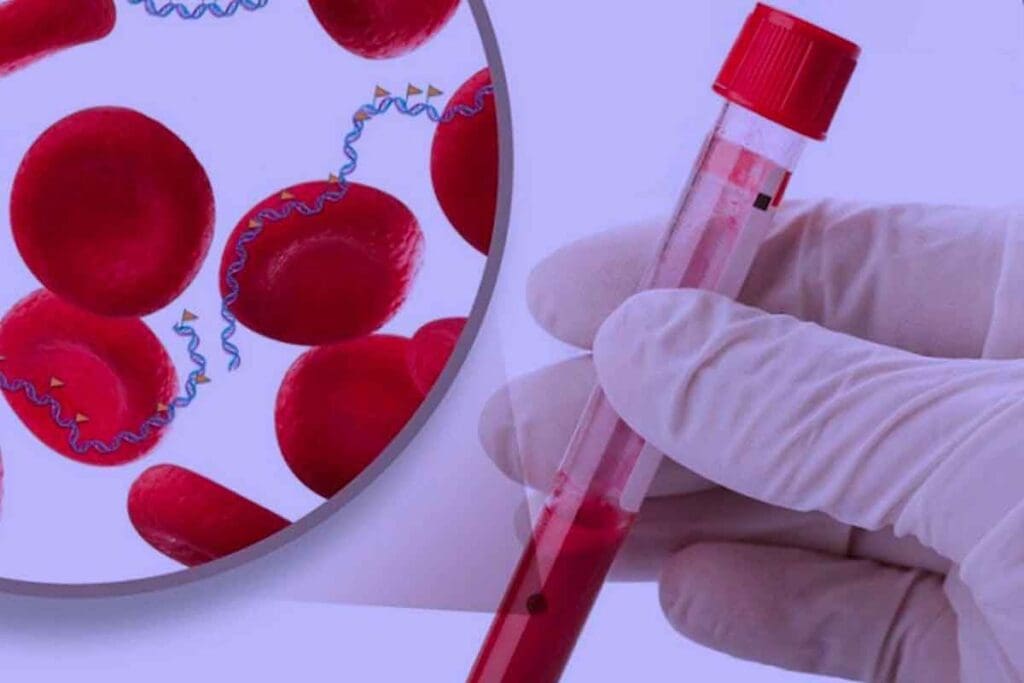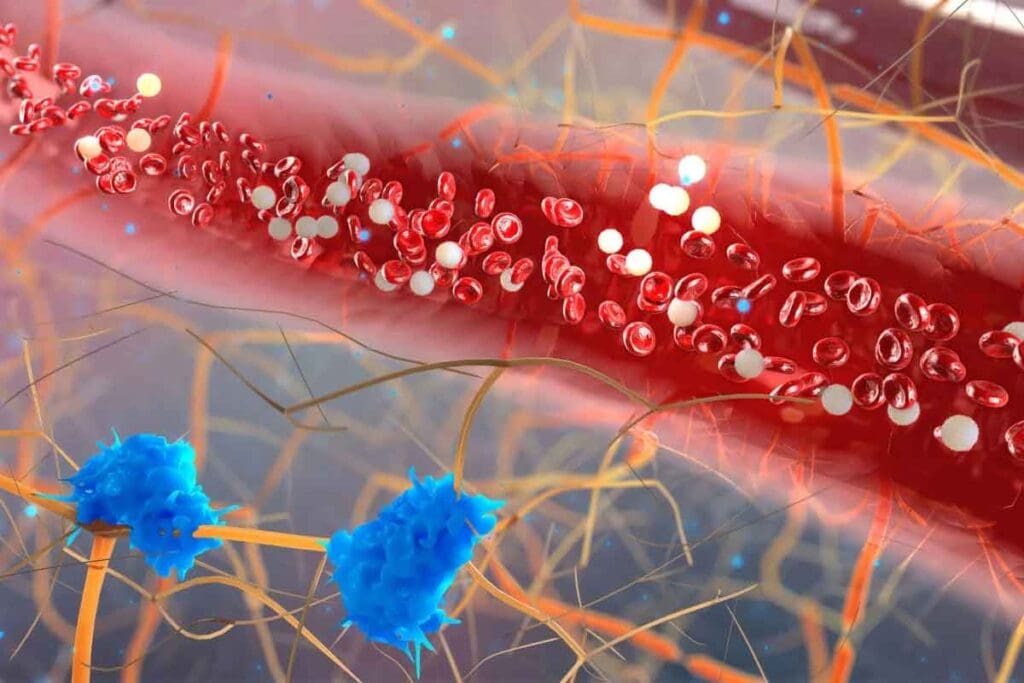Last Updated on November 17, 2025 by Ugurkan Demir

At LivHospital, we know that blood cancer touches millions globally. It impacts blood cells, bone marrow, and the lymphatic system. The main types are leukemia, lymphoma, and myeloma. Knowing these types is key for early detection and treatment.
The Leukemia & Lymphoma Society says about 1,698,339 people in the U.S. live with or have beaten leukemia, lymphoma, myeloma, MDS, or MPNs. We offer patient-focused care and the latest standards. Understanding what are the 3 types of blood cancer helps patients and families better grasp these conditions and ensures everyone gets the best care for these tough diseases.

To understand blood cancer, we need to know how it starts and what increases its risk. Blood cancer, or hematologic cancer, affects blood cell production and function. This can lead to serious health problems. We will look into how blood cancer develops and its common risk factors.
Blood cancer starts with genetic mutations in blood cell DNA. This leads to uncontrolled cell growth. It disrupts normal blood cell production, making it hard for the body to fight infections and heal.
Faulty DNA makes blood cells turn cancerous. This affects the bone marrow, blood cells, lymph nodes, and other parts of the lymphatic system.
Several factors can increase the risk of blood cancer. These include genetic predispositions, exposure to certain chemicals, and previous radiation therapy. Family history also plays a role, as some blood cancers can run in families. Knowing these risk factors is key for early detection and prevention.
Environmental exposures, like benzene or other toxic substances, also raise the risk of blood cancer. We will explore these factors to give a full understanding.

There are three main types of blood cancer: leukemia, lymphoma, and multiple myeloma. Each affects different parts of the blood and lymphatic system. Knowing about these types helps us understand blood cancer better and how to treat it.
Blood cancers are sorted by the cells they start in and how they grow. Leukemia begins in the bone marrow and messes with white blood cell production. These cells fight infections. Lymphoma comes from lymphocytes, a type of white blood cell, and affects the immune system. Myeloma starts in plasma cells in the bone marrow, messing with antibody production and possibly causing bone damage.
“The way we sort blood cancers is key to picking the right treatment,” a top hematologist notes. “Each cancer type has its own set of problems and challenges.”
These cancers affect the body’s blood-making tissues in different ways. Leukemia makes too many bad white blood cells, pushing out good ones in the bone marrow. Lymphoma makes lymph nodes big and messes with the immune system’s fight against infections. Myeloma fills the bone marrow with bad plasma cells, causing anemia, bone pain, and more infections.
Each blood cancer type has its own set of problems and needs a special treatment plan. By knowing the details of leukemia, lymphoma, and myeloma, doctors can make treatments more effective.
Leukemia is a term for blood cancers that start in the bone marrow. It happens when abnormal blood cells grow too much. This can cause many health problems. We will look at the different types of leukemia and what makes them unique.
Leukemia is split into two main types: acute and chronic. Acute leukemia grows fast and needs quick treatment. It’s caused by immature blood cells that don’t work right. Chronic leukemia grows slower and can be treated more slowly. It involves mature blood cells but also leads to too many abnormal cells.
Leukemia is also divided by the blood cell type it affects. Myeloid leukemia impacts cells that make red blood cells, platelets, and some white blood cells. Lymphocytic leukemia affects lymphocytes, which are key for the immune system. Knowing if it’s myeloid or lymphocytic helps decide the right treatment.
It’s important to know the symptoms of leukemia to get early treatment. Common signs include feeling very tired, getting sick often, and bleeding easily. Other signs might be swollen lymph nodes, bone or joint pain, and losing weight without trying.
Lymphoma is divided into Hodgkin and non-Hodgkin types. It affects the lymphatic system, a key part of our immune system.
The lymphatic system fights off infections and diseases. Lymphoma can harm this function, causing health problems. We’ll look at the types of lymphoma and their effects on the body.
Hodgkin lymphoma, or Hodgkin’s disease, has Reed-Sternberg cells in lymph nodes. It’s rare and follows a predictable pattern.
Symptoms include:
Non-Hodgkin lymphoma is more common and diverse. It can occur in lymph nodes, spleen, and other organs.
Symptoms vary by location and type. Common ones are:
Spotting lymphoma symptoms early is key for treatment. Symptoms can be like other illnesses, but seek help if they last or are severe.
Knowing the signs of lymphoma is important. Early detection can greatly improve treatment chances.
Lymphoma is complex with many subtypes. Knowing each type’s specifics is essential for managing and treating it. We’ll keep exploring lymphoma and other blood cancers.
Multiple myeloma is a complex cancer that starts in the bone marrow. Here, plasma cells turn cancerous. This disrupts the body’s ability to make antibodies, causing many problems.
Multiple myeloma harms the bone marrow by filling it with cancerous plasma cells. This pushes out healthy blood cells. It leads to anemia, infections, and bone damage.
The bone marrow can’t make normal blood cells anymore. This causes many health problems.
As the cancer grows, it can make bones weak and prone to breaking. It also weakens the immune system, making infections more likely.
Symptoms of multiple myeloma include bone pain, fatigue, and frequent infections. Some people also get hypercalcemia, causing confusion and constipation.
Treatments can also cause problems. For example, some patients may get kidney damage from the cancer. It’s important to manage these issues to improve life quality.
The stage of multiple myeloma helps doctors decide how to treat it. The Revised International Staging System (R-ISS) is often used. It looks at serum albumin, beta-2 microglobulin, and chromosomal changes.
Knowing the stage is key to understanding the prognosis and choosing the right treatment. The stages range from Stage I to Stage III, with Stage III being the most severe.
Rare blood cancers, like myelodysplastic syndromes and myeloproliferative neoplasms, are tough to diagnose and treat. While leukemia, lymphoma, and multiple myeloma are well-known, these rarer conditions also significantly impact patients’ lives.
Myelodysplastic syndromes (MDS) are disorders where blood cells don’t form right. This often leads to bone marrow failure. Symptoms can vary but often include fatigue, infections, and bleeding disorders.
Key characteristics of MDS include:
To diagnose MDS, doctors use blood tests, bone marrow biopsy, and genetic testing. These help figure out the risk and severity of the condition.
Myeloproliferative neoplasms (MPN) are diseases where too many blood cells are made. This can cause blood clots, spleen enlargement, and an increased risk of turning into acute leukemia.
Common types of MPN include:
Symptoms of MPN can vary but often include fatigue, weight loss, and an enlarged spleen. Treatment aims to reduce complications and manage symptoms.
It’s important to understand the differences between MDS and MPN for effective management and treatment. The following table summarizes key aspects of these rare blood cancers:
| Characteristics | Myelodysplastic Syndromes (MDS) | Myeloproliferative Neoplasms (MPN) |
| Primary Issue | Bone marrow failure, ineffective hematopoiesis | Overproduction of blood cells |
| Common Symptoms | Fatigue, infections, bleeding disorders | Fatigue, weight loss, enlarged spleen |
| Risk of Progression | Risk of transforming into AML | Risk of transforming into acute leukemia |
We recognize that rare blood cancers like MDS and MPN need specialized care. By understanding their unique characteristics and challenges, we can better support patients in their journey towards diagnosis and treatment.
Getting a correct diagnosis of blood cancers is key for the right treatment and better health outcomes. Finding out about blood cancers involves several steps. These steps help figure out if the disease is there, what type it is, and how far it has spread.
Many tests are used to spot blood borne cancer and figure out its type. These include:
These tests help doctors find cancer cells in blood. They also figure out the exact type of blood cancer, like leukemia, lymphoma, or multiple myeloma.
After finding out what kind of cancer it is, the next step is to figure out its stage. Knowing the stage is important for understanding the cancer in the blood prognosis. It also helps pick the best treatment plan.
Staging for blood cancers depends on the type:
Knowing the stage of blood cancer helps patients and doctors make better choices about treatment. It also helps predict what might happen next.
Managing blood cancers requires a variety of treatments. Each patient’s needs are different, so we tailor therapy to fit them best.
Chemotherapy is key in treating many blood cancers. It uses drugs to kill cancer cells. We often mix it with other treatments to make it work better. Radiation therapy, which uses rays to target cancer cells, is also important.
Stem cell transplantation, including bone marrow transplantation, is a major treatment for some blood cancers. It replaces damaged stem cells with healthy ones, helping the blood system to heal.
Types of Stem Cell Transplantation:
Targeted therapies aim at specific molecules in cancer cells, making treatment more precise. Immunotherapies use the immune system to fight cancer.
Clinical trials are essential in improving blood cancer treatments. They offer new and innovative therapies. We suggest patients consider clinical trials as part of their treatment.
The field of blood cancer treatment is always growing. Researchers are working on better and less harmful therapies.
Blood cancer survival rates have been getting better over time. This is thanks to new medical treatments. Knowing the prognosis is key for patients and their families. It helps them make smart choices about treatment.
Many things can change a blood cancer patient’s survival chances. These include the type of blood cancer, how far along the cancer is, the patient’s age, overall health, and how well they respond to treatment.
The type of blood cancer matters a lot. Different cancers have different chances of survival. For example, some types of leukemia are easier to treat than others.
Survival rates for five years differ a lot among blood cancers. For instance, leukemia survival rates have gone up thanks to new treatments. Lymphoma patients have also seen better outcomes, thanks to better chemotherapy and radiation.
Living with blood cancer is more than just fighting the disease. It’s about keeping a good quality of life. This means managing symptoms, dealing with treatment side effects, and getting emotional and psychological support.
Patients should talk to their healthcare providers about their quality of life concerns. This way, they can get the support they need.
It’s important to know about the three main types of blood cancer. These are leukemia, lymphoma, and myeloma. They affect the blood, bone marrow, and lymphatic system. Each type has its own diagnosis, treatment, and outlook.
We’ve looked at how these cancers develop and their risk factors. We’ve also talked about treatments like chemotherapy and targeted therapies. Knowing about these cancers helps patients and doctors make better choices.
Dealing with blood cancer needs a team effort and ongoing research. This research helps improve survival rates and quality of life. As we learn more, we can find better treatments and support for those affected.
Together, we can help patients with leukemia, lymphoma, and myeloma. We can improve their outcomes and make a difference in their lives.
The main types of blood cancer are leukemia, lymphoma, and multiple myeloma. They affect the blood cells, bone marrow, and lymphatic system.
Leukemia is a blood cancer that affects the blood and bone marrow. It causes abnormal white blood cells to grow. This can lead to anemia, infections, and bleeding problems.
Acute leukemia grows fast and needs quick treatment. Chronic leukemia grows slower and might not need immediate treatment.
Lymphoma is a blood cancer that affects the lymphatic system. It’s divided into Hodgkin and non-Hodgkin lymphoma. Each has its own treatment.
Multiple myeloma is a blood cancer that affects plasma cells in the bone marrow. It can cause anemia, bone pain, and infections.
Symptoms include fatigue, weight loss, fever, night sweats, and swollen lymph nodes. Symptoms vary by blood cancer type.
Doctors use physical exams, lab tests, and imaging to diagnose blood cancer. Tests include blood tests, bone marrow biopsies, and scans like CT or PET.
Treatments include chemotherapy, radiation, stem cell transplants, targeted therapies, and immunotherapies. Treatment depends on the disease type and stage.
Prognosis varies by disease type, stage, age, and health. Five-year survival rates are available for different blood cancers.
Rare blood cancers include myelodysplastic syndromes (MDS) and myeloproliferative neoplasms (MPN). They cause abnormal blood cell production and increase leukemia risk.
Blood cancer can greatly affect quality of life, causing fatigue, pain, and emotional distress. Managing symptoms and maintaining well-being is key for patients.
Subscribe to our e-newsletter to stay informed about the latest innovations in the world of health and exclusive offers!